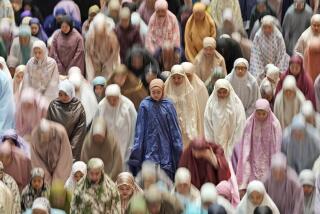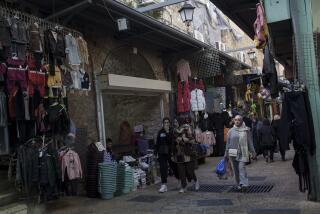Modern Face, Ancient Heart
- Share via
MUSCAT, Oman — A mere 30 years ago this country had no tourist trade, only a few miles of paved roads, a single power plant and scant phone service. People walking in the dark carried lanterns lest they be shot as thieves, and this city’s wooden gates were closed to outsiders after dark.
My wife, Susan, and I knew times had changed, but upon arrival last December, we were pleasantly surprised at what we found: a clean, pleasant and progressive nation that welcomes travelers.
With an economy driven by oil and shipping and a sultan intent on catching up with the 21st century, a new Oman has emerged: hundreds of miles of paved highways, a nationwide electric system, modern telecommunications. Even the Muscat port rivals any in the Persian Gulf in terms of the quality of facilities and volume of commerce. Social progress? Women serve on the sultan’s advisory Consultive Council, and the country has the Gulf’s first female ambassador.
Oman, on the eastern edge of the Arabian Peninsula facing Iran, turned out to be the best part of an around-the-world trip Susan and I took. We wanted to spend Christmas and New Year’s with our daughter, Karen, who is vice consul at the U.S. Embassy in nearby Bahrain, and she recommended a side trip to Oman for the week between the holidays. We were joined by our son, Michael, who was on semester break from veterinarian school.
We focused our visit on northern Oman, mostly in and around the capital, Muscat (pronounced MOOS-cat). But everywhere we went in this country of 2.3 million, we found a land that is blessedly beautiful: rugged mountains, 1,060 miles of coastline with golden beaches and majestic fiords in its northern peninsula.
Our visit was during the temperate season (October through March), when daily high temperatures on the coast average in the 80s and low 90s.
The trip also coincided with Ramadan, the Islamic holy month celebrating the revelation of the Koran to the prophet Muhammad. Muslims fast from sunrise to sunset, and even most non-Muslims forgo food and drink in public during daylight hours. We knew this might pose problems during our journey, but my wife’s work schedule (she is a college professor) dictated the timing of the trip. In retrospect, we’re glad we visited during Ramadan; it allowed us to experience another aspect of a culture we knew little about.
After a flight from Bahrain, our 45-minute rental-car ride from the airport to Muscat whetted our appetite for the days ahead. We passed the dazzling neoclassical architecture of the government center, the beautifully landscaped grounds and jagged peaks in the distance. Every so often, we glimpsed the sparkling waters of the Gulf of Oman peeking through the mountain passes.
Cyrus the Great made this land part of the Persian Empire in the 6th century BC. Arab tribes migrated about 2,000 years ago. Portuguese colonialism of the 1500s and 1600s gave way to self-rule, and by the early 1800s Muscat was a strategic center of trade and power for the entire Gulf area.
But economic stagnation followed, and the country entered a period of decline and isolation through much of the 20th century. Change didn’t arrive until Sultan Kaboos ibn Said, in a bloodless coup, wrested power from his father in 1970. The young sultan modernized the economy, repealed travel restrictions and improved international relations.
En route from the airport, we passed the royal palace in Muscat. The greater Muscat area includes the capital proper as well as the districts of Ruwi and Matrah; all three areas are separated by small mountains and canyons but linked by freeways.
Old and new exist in marvelous counterpoint in Muscat proper. The modern Al Khawr Mosque sits in the shadow of Al Mirani Fort, a 16th century battlement that dominates the harbor entrance. The nearby ruins of Al Jalali Fort--like Mirani, an ancient Arab outpost rebuilt by the Portuguese--overlook the contemporary royal palace. Modern government buildings lie enclosed in a replica of the original city wall.
The densely populated district of Ruwi is the commercial center of greater Muscat, with most of the large hotels, shops and office buildings. After dark, the gold shops in the Ruwi marketplace are busy as veiled women bargain hard for ornate, beautifully handcrafted gold necklaces and bracelets. Although the area is the city’s most metropolitan, it held the least appeal because of the traffic and unabashed commercial tone.
We favored the district of Matrah, known for its harbor-side promenade, called the Corniche, and for its souk.
Matrah is the main trading and port area and, for visitors, a delightful place to stroll, shop, eat and people-watch.
We walked past women, some in long black robes called abaya. Some wore bird-like leather masks called burkhas--worn for allure, not societal obligation--as they shopped or ran daily errands. (Female tourists need not wear a veil.)
Men in long white robes called kandura (or dishdasha) and small, embroidered headpieces called kumma tended to business or socialized until it was time to pray at the mosque.
Most of the high-end Western-style hotels are in Ruwi. But the Corniche is home to three modest choices, including the Hotel Mina. For about $45, we got a triple room, which was was nothing fancy but clean and adequate with a view of the harbor. The hotel was steps away from the bustling Municipal Market, with its fish, meat, produce and other perishables, and a short walk to the souk and its dry goods.
At the Municipal Market, dozens of fishmongers in traditional robes hawked their selection or bid for the fresh catch just off the boats. (Omani waters hold tuna, mackerel, shark and shellfish.) Other merchants carefully displayed fresh lamb and goat meat, or set out tantalizing citrus, eggplant, tomatoes and other produce.
Down the Corniche, the souk opens midmorning, then closes in the afternoon because of the heat. In the late afternoon, it stirs again in preparation for the evening shopping hours. By the time we arrived, food vendors were preparing delicious meat-filled dumplings, tea and pastries to satisfy the hunger from the past 12 hours’ fast.
Omanis dined and socialized into the early hours of the morning at restaurants and at Ramadan tents. Half the size of a football field, the tents offered kalawi (kidney) kebab; tikka laham (marinated lamb); shawarma; falafel and hummus; and exquisite drinks made with blended strawberry, banana or cherry juices and mint.
The crowd passed the time by playing cards or board games, or by smoking a shisha, a 3-foot-tall water pipe. The instrument burns and filters flavored tobacco--mango, orange, melon and cappuccino, among others.
We walked through the compact souk, where the shelves were bursting with clothing, housewares, toys, perfume, candles and other goods.
A few shops offered gifts or souvenirs, and we browsed through Omani handicrafts and unusual artifacts, especially the silver. The most popular items are intricately made silver boxes, belts, jewelry and the traditional khanjar, a curved ceremonial dagger.
After exploring Muscat, we took a day trip to Nizwa, a leisurely three-hour drive to the southwest. Adjacent to the city’s blue-domed mosque is the 350-year-old Nizwa Fort, with its narrow passageways and steep staircases. The structure was built as the palace, prison and seat of government for Sultan bin Saif, the first imam (ruler) of the Al-Yaribi Dynasty.
Our second excursion was to the Musandam Peninsula, on the Strait of Hormuz in the north. A two-hour flight on Oman Air took us along the tranquil coast. (Musandam is separated from Oman proper by the United Arab Emirates.)
I had made reservations at the Khasab Hotel, the only choice in the village of Khasab. We were eager to look around, and with no taxis available, we reluctantly settled on the hotel’s day rate of $62.50, fuel extra, for an old four-wheel-drive truck. (The price seemed high and probably was the only negative of the trip.) Without asking for so much as a signature or a deposit, the desk clerk handed us the keys and said farewell.
We circled through the sleepy village a few times to get oriented, then headed south about 15 miles toward the Khor Najd, one of several magnificent fiords and the only one accessible by car.
The drive wasn’t easy; the road was dusty, rough, steep and winding. But from the top of a ridge we were rewarded with a spectacular 360-degree panorama: rugged mountains, isolated beaches, sweeping bays and the indigo sea.
The highlight of our Musandam visit was back near town at Khasab’s harbor. On any given night, hundreds of Iranian smugglers cross the 25-mile-wide strait from Bandar Abbas in small outboard skiffs ferrying goats and sheep for sale in the United Arab Emirates. The boats pack the small harbor, and in the early daylight, the live animals are tossed by the hundreds in bucket-brigade fashion into trucks on the beach. Susan and I had never seen anything like it in 30-plus years of traveling. By midmorning Omani customs officials have extracted a small processing fee and sent each truck south to the Emirates, where the cargo is sold to market. With money from the goats, the smugglers buy loads of cigarettes, which are run back to Iran, again under cover of darkness to avoid import or export taxes.
Back in Matrah, on our last night, prayers began well before sunrise at a grand mosque a short block away from our hotel. We awoke in the darkness and heard a hypnotic chant by the muezzin. The special prayer, we learned later, was meant to bestow an abundance of blessings. And we certainly felt blessed to experience this engaging place.
(BEGIN TEXT OF INFOBOX / INFOGRAPHIC)
GUIDEBOOK / Touring Oman
Getting there: The trip from LAX to Seeb International Airport near Muscat, Oman, requires several stops. Fly American, British or Virgin airlines to London, then connect to Gulf Air or Lufthansa, which fly through Frankfurt, Germany, to Muscat. Restricted round-trip fares begin at $2,173.
Where to stay: In the greater Muscat area you’ll find chains such as Hyatt, Sheraton and Crowne Plaza. We chose places with mostly Omani clientele.
Hotel Mina overlooks the harbor on the Corniche in the Matrah district, mailing address P.O. Box 504, Ruwi 112; telephone 011-968-711828, fax 011-968-714981. Our room for three was $45.
Another option is the Corniche Hotel, P.O. Box 1800, Matrah 114; tel. 011-968-714636, fax 011-968-714770. Doubles are about $35.
On the Musandam Peninsula, we stayed at the Khasab Hotel near the airport, P.O. Box 111, Musandam 811; tel. 011-968-830271, fax 011-968- 830989. It’s the only hotel in town; our room was $72.50.
Where to eat: Our first night in the Muscat area, we ate at Aroos Al-Bahar, a harbor-side kiosk. A delicious grilled fish dinner for three, with rice, pita, salad and beverages, was $18. There’s no phone; look for the red-and-white stand across from the Mina Hotel.
The blended fruit juices (about $2.30 for a large) were worth a stop at Al Ahli Restaurant and Coffee Shop, in the Matrah souk on the Corniche.
In the Ruwi district, we liked Spicy Village Restaurant, near the Ruwi Roundabout; local tel. 700175. Dinner for three--chicken tikka masala, chickpea masala, prawn do pieza (onion)--was $23.
For more information: Oman Embassy, 2535 Belmont Road N.W., Washington, DC 20008; tel. (202) 387-1980.
More to Read
Sign up for The Wild
We’ll help you find the best places to hike, bike and run, as well as the perfect silent spots for meditation and yoga.
You may occasionally receive promotional content from the Los Angeles Times.






